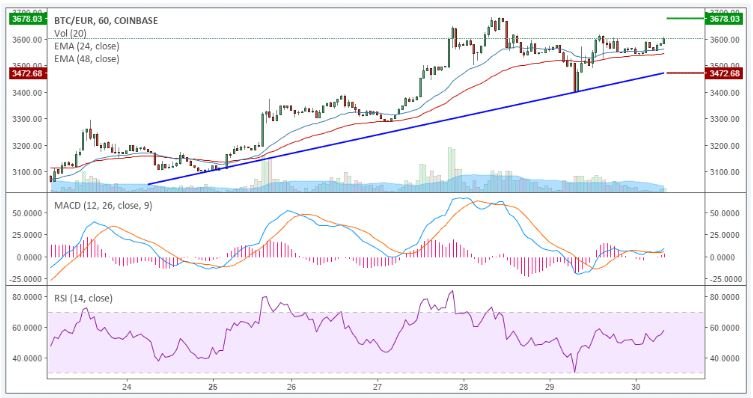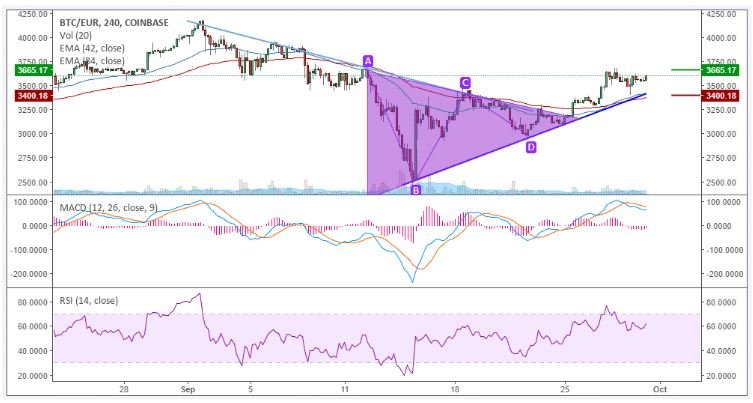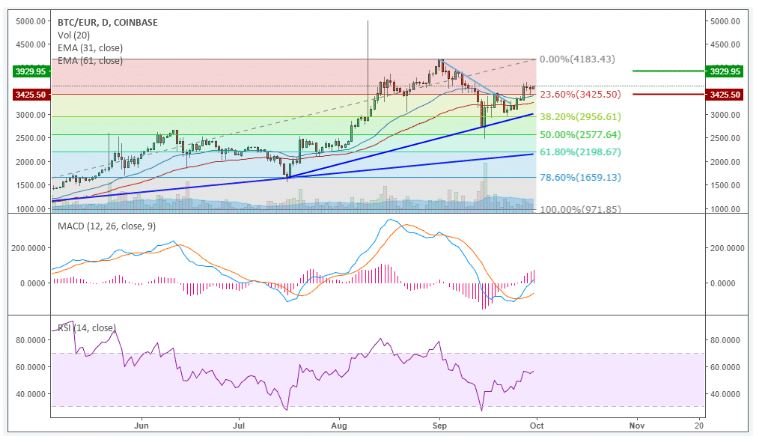
- Japan issues Licenses for Crypto Exchanges!
- US Government: Blockchain as an Advantage for the Future!
- Media Reports: South Korea bans ICOs!
- Bitcoin Course Analysis for Week 39/2017!


As a result of the implementation of stronger regulatory measures, the Japanese Financial Services Agency has now issued an official license to act in the Asian country for 11 crypto exchanges.
As reported earlier this week, Japan is planning to take a closer look at the trading of crypto currencies from next month. The basis for this is a law on regulation, which should primarily protect against the misuse of digital currencies, such as money laundering activities. In addition, the Know-Your-Customer-Principle (KYC) has set a standard which leads to an annual audit. The same law had also officially declared Bitcoin in Japan officially as the legal means of payment.
According to news agency Reuters, the first official licenses have been awarded to crypto exchanges.
Just before the Act comes into force, this can be seen as one of the final steps in its implementation. Previously, the vendors had been thoroughly examined for pre-determined basic conditions. These 11 crypto exchanges now have a legal status, which confirms that they are able to meet all standards under the new regulation law. Accordingly, they are still able to pursue their business without any restrictions. Besides the 11 now officially recognized crypto exchanges, there are currently 17 more still in the examination phase, while 12 more have not been able to fulfill the necessary conditions.
In the midst of the current wave of regulation, which in the case of Japan's East Asian neighbors, China and, more recently, South Korea, express in prohibitions, Japan seems already a step further in its regulatory efforts. From October on, for example, the law helps to curb the wild growth of the Japanese crypto market and to direct it into regulated channels. This regulatory step not only brings security and stability to Japan's crypto trade, but also represents the probably only path for the crypt industry to grow sustainably in the long term. In this sense, we can only hope that others will follow this example - above all the countries of the region.


The US government underscores its commitment to the state use of blockchain and cryptography technology and intends to set sail for the future, a high-ranking government official from the White House said at Data Transparency 2017 last Tuesday. The aim of the conference is to explore and communicate forms of the open government, and to push forward with the US government. At the same time, officials emphasized the essential importance of this technology for the future of US policy, public administration and the population.
At the Open Data Summit on Tuesday, no one was less than Margie Graves, a senior officer in the Office of Management and Budget (OMB), the US Cabinet of Administration and Households, and Trump consultant Chris Liddell directly from the White House to the Renaissance Hotel in Washington were there.
The presence and the lectures of the officials are crucial. The OMB, led by Mick Mulvaney, co-founder of the Congressional Blockchain Caucus, the blockchain working group in the US Congress, is directly responsible for the shaping of the executive policy - the vision of Donald Trump for the future of the US.
Not to be outpaced
Thus, it was little surprise that Margie Graves represented the American government at the conference as a strong advocate of blockchain technology.
Margie Graves said:
In her talk, she underlined the need to further explore technologies so as not to be subject to prior art.
Margie Graves was open to discussing blockchain and cryptography solutions in the update of the Open Government National Plan, which is expected at the end of the year. In this way, it already highlighted specific fields of application for the technology: in the future, blockchain solutions could play a decisive role not only in terms of cybersecurity, but also in combating fraud or food waste. Together with Blockchain expert Don Tapscott, Graves wanted to identify further possibilities of public application in the next week.
Chris Liddell, a government consultant and strategic director of the White House, was less concrete in his speech: He spoke out for standardized data solutions. Only in this way would it be ensured that technologic solutions such as blockchain or artificial intelligence could be successfully adapted in the future. Liddell appealed that the government should not block the future of tomorrow with today's reforms. The New Zealander, together with Trumps chief economist Gary Cohn, is part of the Office of American Innovation, the department in the White House, which is dedicated to the public potential of future-oriented technologies.
With a determined attitude
The fact that the US government is so prestigious reflects the great enthusiasm of the Trump administration for Blockchain and Distributed Ledger Solutions, and speaks no less for the technology itself. Not only the intercession of the Chief Economist of Vice-President Mike Pence, Mark testify Calabria, but also several official blockchain pilot projects of the US government. Thus, governmental institutions such as the American Center for Disease Prevention and the Federal Administration's General Service Administration are experimenting with blockchain solutions.
Moreover, these projects are supported by an extroverted financing system. For example, the US Department of Homeland Security (DHS) has provided substantial financial support this week, the blockchain startup Digital Bazaar, with around three million dollars. Digital Bazaar and other smaller blockchain companies have received grants from the US Support Fund, the Business Innovation Program (SBIR), in the past. With the help of the funds, the companies are now to promote the development of suitable blockchains for various applications of governmental use.
Alone on a wide corridor?
However, the American economy is also increasingly focused on blockchain solutions. This is demonstrated by the view on the blockchain patent applications that industry-wide research is being carried out on the technology. In the first half of 2017, the number was 390. The number of applications for the coveted exclusive rights, according to data from the US Patent Office, almost doubled compared to the previous year.
The white house, with its strategic opening-up of state blockchain use, does not stand alone, as the pioneering paths among the state users show. In 2017, for example, the EU has invested 5 million euros in blockchain research. In Estonia, blockchain is already a daily routine in public administration, and since that year, its blockchain-based land registry has been operating as a pilot project. However, if the US is to continue investing further, investing state and public awareness in the near future, the Blockchain on the state level will have the confidence that they will soon be forced to go to the stag.


According to consistent media reports, South Korea has decided to ban all types of Initial Coin Offerings (ICO). This was announced by the regulator on Friday. However, this has no direct effect on the trade of crypto currencies in South Korea.
On Friday morning, several international media, including Reuters news agency, CNBC, the Business Insider and the Financial Times, reportedly disregarded the announcement by the Financial Services Commission (FSC) of South Korea to ban all forms of money laundering based on cryptanalysis. The Commission had "serious concerns about the fact that current market assets are being postponed in an unproductive, speculative direction." The decision had been taken by the FSC after a meeting with representatives from the Ministry of Finance, the South Korean Central Bank Bank of Korea and the South Korean tax authority.
"Money collecting through ICOs seems to be growing around the globe and our observation is that the number of ICOs is also increasing in South Korea," the regulators are quoted. Financial institutions or other actors who are involved in the implementation of an ICO are also faced with "severe penalties", it says, without continuing the nature of these penalties.
The main reason for the drastic measures in South Korea can be seen the increasing fear of fraud and financial scams, which South Korea's official worries. However, the mere ban on ICOs does not automatically imply that any other trade in crypto currencies in South Korea could be restricted in any way. A similar development as in China two weeks ago appears highly unlikely. Correspondingly, the crypto courses on Friday afternoon responded only with minor rashes down. However, the announcement implied that the South Korean government's precautionary measures also include increased monitoring and control of the crypto market to more effectively protect traders and investors from possible misuse.


And it goes up again! This week, the course was able to rise to EUR 3,678.03 (USD 4,344.75) and currently stands at EUR 3,602.26 (USD 4,255.24).
Image based on data from coinbase.com
Summary
- The Bitcoin course has increased during the week.
- With a dip at EUR 3,102,23 (USD 3,664.57), the price entered an upward trend that led to a weekly maximum price of EUR 3,678.03 (USD 4,344.75).
- The most important short-term resistance is EUR 3,678.03 (USD 4,344.75), the most important short-term support is EUR 3,762.68 (USD 4,102.17).
The Bitcoin course has been extremely stable during the week. Even if the situation in China has not relaxed, it looks like a new wave of ICO regulations in South Korea, and other financial giants of the old school responded to Bitcoin's expectations, the shift of the focus to Japan led to a still stable price development. Accordingly, the price is in an uptrend and could rise above the exponential moving average over a day or two. Currently, however, the course is on a light plateau, which is why a further look at the indicators is interesting.
The MACD (second panel) is positive, as is the MACD line (blue) above the signal (orange).
The RSI (third panel) stands at 58 and is therefore bullish.
The analysis of the movements in the 60min chart speak a bullish language. The most important support in this chart is described by the uptrend and is EUR 3,472.68 (USD 4,102.17). Prior to this, however, the exponential moving average values must be broken down for one or two days, which are EUR 3,569.28 (USD 4,216.28) and EUR 3.549.97 (USD 4,193.47), respectively. The most important resistance is described by the week maximum and is EUR 3,678.03 (USD 4,344.75).
The long term course development
Let us consider the 240min chart as the first to assess medium and long-term developments:
Image based on data from coinbase.com
The downtrend, which determined the September, was broken after a symmetrical triangle pattern! Accordingly, the price could rise above the exponential moving average over one or two weeks. These have now also crossed a golden cross. The exponential moving average has thus risen over a week over the exponential moving average over two weeks, which indicates a still stable uptrend.
The MACD is positive according to these positive developments, but the current consolidation phase caused the MACD line to fall below the signal. The RSI was slightly overbought, but remains bullish 60. In the medium term, the situation is bullish. The most important support is EUR 3,400.18 (USD $ 4,016.53), which corresponds to the support of the uptrend and the current exponential moving average over a week. The most important resistance is described by the most recently achieved maximum and is EUR 3,665.17 (USD 4,229.56).
Let's take a look at the 1D chart:
Image based on data from coinbase.com
Again, the end of the downtrend is clearly visible. Due to the course minima in July and in September, another long-term upward trend has emerged, which is steeper than the previous uptrend. The price could again climb over the exponential moving average over a month or two months and overcome the resistance described by the 23.6% Fib retracement level at EUR 3,425.50 (4,091.66 USD).
Overall, the long-term forecast is bullish. The most important support is described by the former Resistance, ie the 23.6% Fib retracement level at EUR 3,425.50 (USD 4,091.66). The most important resistance before the all-time high is described by the temporary maximum on 7 September and stands at EUR 3,929.95 (USD 4,642.33).
Disclaimer: The course analysis is from the morning MUT time zone and can have changed since. The price estimates presented in this post are not a recommendation to buy or sell. They are merely an estimate of me.

I wish you all a lovely Saturday and a great Weekend!!!
ⓁⓄⓥⒺ & ⓁⒾⒼⒽⓉ
Best regards
@danyelk
.gif)








I see this all as good news. It shows that its only a matter of time before blockchain technology and cryptocurrencies become mainstream. It may actually be sooner rather than later as all these governments are starting to focus on regulations etc. not to forget the imf have also commented on bitcoin in the last couple of days. Lets keep pushing this revolution...
@danyelk almost forgot, good post and keep up the good work...
Thank you I will :)
Yes your right soon it will go mainstream and everybody involved like miner trader etc. will finally benefit like they deserve.
It will be awesome...
These days Japan and Korea pulled the spotlight from China, thanks.
Ohhh yes they did and I love them for it :)
whats up with all of those bans
This post has received a 1.91 % upvote from @buildawhale thanks to: @danyelk. Send at least 0.50 SBD to @buildawhale with a post link in the memo field for a portion of the next vote.
To support our curation initiative, please vote on my owner, @themarkymark, as a Steem Witness
This post received a 1.6% upvote from @randowhale thanks to @danyelk! To learn more, check out @randowhale 101 - Everything You Need to Know!
This post has received a 2.35 % upvote from @boomerang thanks to: @alexvan
@boomerang distributes 100% of the SBD and up to 80% of the Curation Rewards to STEEM POWER Delegators. If you want to bid for votes or want to delegate SP please read the @boomerang whitepaper.